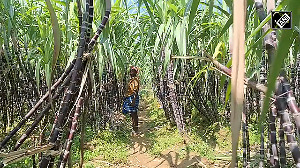Where is the nearest Dalit village? So long as this question is asked in India, there is no India shining, India emerging, or as -- United States President Barack Obama said in New Delhi -- an emerged India, notes Smita Prakash.
There is filth everywhere. Rotting mounds of garbage, which has probably never been cleared. It just keeps piling, layer upon layer. The gutters are overflowing. Man and pig cohabit. The stench is unbearable.
I walk gingerly, placing one foot ahead of the other to avoid animal faeces. I look around, nobody other than I has a cloth covering his or her nose. It appears worse than many similar towns that I have been to, in the rest of India.
This seems to be the same Bihar I have visited earlier. Same problem of a lack of civic facilities here too, just like before, and just like in Uttar Pradesh, Orissa, Andhra Pradesh. Any state for that matter.
The people seem oblivious to the smell and the filth around them. And amidst all this decay, there stands a bright red pandal (decorative tent) with a garishly attired statue of the Mother Goddess. It is the most important festival of Chhat and people of all castes are allowed, by tradition, to participate in the festivities.
Tradition and modernity, vulgar modernity, mingle outrageously. Munni badnaam hui, a raucous song from the latest Bollywood film Dabangg, blares from loudspeakers. I take my pictures like any big city-dweller, searching for colour in India but finding squalor instead.
Arvind Adiga's Booker award-winner The White Tiger comes to mind. The stark contrast between rural and semi-urban India on the one hand, and the glass skyscrapers of Gurgaon, Haryana, on the other. Yes, Rahul Gandhi is probably right; there are two Indias, and more.
My destination is a Mahadalit village. Now, the term Dalit has roots in Sanskrit where the root ''dal'' means ''to split, crack, open''. Dalit has thus come to mean things or persons who are cut, split, broken or torn asunder, scattered or crushed and destroyed.
The present usage of the term Dalit goes back to the nineteenth century, when Marathi social reformer, Mahatma Jyotirao Phule, used it to describe outcastes and untouchables as the oppressed and the broken victims of our caste-ridden society.
But I'm deeply fascinated by the term Mahadalit at many levels. That there is a term called Mahadalit. Although it can be literally translated as "Mega Dalits", what does it really mean -- the blessed among the Dalits or the most depressed section among the Dalits? I am told it is the latter --- the most deprived of the deprived.
Mahadalit is a term created with great political fanfare in 2007, when Bihar's Nitish Kumar government set up the Mahadalit Commission to identify Mahadalits, ostensibly for a better targeting of schemes for their upliftment and development.
According to the commission, there were three criteria of inclusion: literacy rates, placement in services and social stigma. The commission identified 18 of Bihar's 22 Dalit castes as Mahadalit. The four groups that were excluded were: Jatavs and Paswans, together accounting for more than 60 per cent of Bihar's Scheduled Caste population; and Dhobis and Pasis, the two groups considered relatively better off among Dalits.
In 2008, Pasis and Dhobis were also included in the Mahadalit list. In 2009, the Jatavs followed them into the burgeoning Mahadalit ranks, leaving out only the Paswans.
In Gaunpura, I am shocked that the Mahadalits live separately from people of other castes, even other Dalits. Hadn't Bihar changed? TV programmes have been telling us so. So my cameraman and I get off the highway into 'kuchcha' roads, drive over a snake, and ask, "Bhaiyya, yahan Dalit basti kahan hai?"(Where is the Dalit village)? Blank. I repeat, "Dalit basti". No response. Then my cameraman whispers, "Harijan basti". We get the directions. Gaunpura is a little hamlet where about 30 families live in abject poverty.
They are well aware of their rights, that they are entitled to housing under the Indira Awas Yojna programme, the Mahatma Gandhi National Rural Employment Guarantee Act should grant them minimum days of work.
Some of them who worked under this scheme, like Ramdev, were not paid for 11 days of labour that he did, out of the 60 days he was employed under the MGNREGA. He has been fighting with the authorities to get that money.
Another says he was thrown in jail when he asked for his complete wages. Bijay Pawan says fake MGNREGA booklets are handed to the villagers to sign in their attendance and then they were cheated of their wages.
Uma Devi is completely illiterate, but has cast her vote a few days back. She says that it is to teach a lesson to those who should have built a house for her under a Central government scheme, but didn't do it.
I visit another 'home' of sorts. Here, 18-year-old Chand is making cow dung cakes to be used as fuel for cooking. Chand was pulled out of school when she was in the seventh grade because her older brothers would not send her to the next village to attend high school.
Has she heard of the state government scheme, I ask her, which entitles her to a cycle so that she can get to a school safely and quickly? With a shy smile, Chand says that her brothers would never allow it because she would have to cycle past an upper caste village.
I drive out to Shahjahanpur, a Hindu upper caste village. The contrast seems stark. The roads cut at right angles; there is round the clock electricity, clean yards and brick-and-mortar homes.
The men wear footwear and vests over trousers, unlike in Gaunpura. The women wear synthetic saris and jewellery. The children are studying in Delhi or Singapore. I spot some Maruti cars and one Honda City as well! There is cable TV connection in all homes. The Dalits live outside the village, and no Muslim family resides in this village called err Shahjahanpur.
Dabangg! This is straight out of the latest Bollywood potboiler Dabangg, it seems. When I ask whom they voted for, pat comes the reply, "Nitish Kumar and the Bharatiya Janata Party... he has reduced lawlessness in the area. We can go out at night without being scared of being kidnapped."
"But what about the Naxalite problem," I ask. "Oh that is only in the poor areas, you know where there is no development." Hmm... So there is an area of complete darkness, some area of substantial darkness and some semi-dark areas in the 'area of darkness' known as Bihar.
Anecdotes may not be evidence but they do tell a story. Last week, in a village near Patna, a 55-year-old Dalit was beaten to death. Retaliatory attacks by Dalits led to several arrests. Lal Babu Ram had walked through the fields of an upper caste landowner. Some say he refused to work in the landowner's fields. Babu Ram is dead. We will never know the truth.
Reporters, who travel with the chief minister during his campaign tours, have filed reports that it is development and not caste, that is the main electoral plank this time in Bihar. This is just spin. Politicians have promised development in every election held in Bihar.
Even today, development doesn't trump caste in Bihar. The choice is not between development and caste. Caste remains a social and political reality in Bihar, which no political leader --- from Nitish Kumar to Rahul Gandhi --- can afford to ignore.
A Brahmin, Rajput or Bhumihar (upper caste Hindu) does not stand a chance of becoming the chief minister of Bihar. In the same vein, the empowerment of the poor among the backward castes is still a long way off.
Villagers want bijli, sadak and pani (electricity, roads and water). Every election, it is the same demand, and the same promise. The message is not new. What is different is the style of delivery.
Nitish Kumar, the current chief minister, doesn't indulge in histrionics as his immediate rival Laloo Yadav. He has indubitably brought about a change in Bihar, at least in some parts of Bihar. But decades of misgovernance have made corruption and criminalisation a part of the system.
Things are changing in Bihar since I was last here. The change, though perceptible, is very slow. Bihar needs to change faster, and change equitably for the complete society. If I, in my lifetime, come to a place in Bihar and don't have to ask, "Where is the Dalit village?" I'd say India has emerged. Else, I am not going to take even President Obama''s word for it.









 © 2025 Rediff.com -
© 2025 Rediff.com -